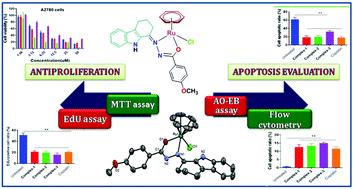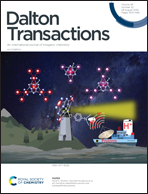Investigation into antiproliferative activity and apoptosis mechanism of new arene Ru(ii) carbazole-based hydrazone complexes†
Abstract
Ruthenium complexes with bioactive ligands are becoming promising substitutes for platinum complexes due to their precise action against various cancers. In the present study, the synthesis of three new arene Ru(II) complexes containing new carbazole-based hydrazone ligands of general formula [(η6-benzene)Ru(L)Cl] (1–3; L = carbazolone benzhydrazone ligands), and their anticancer properties are described. The structural characterization of the ligands and their ruthenium complexes has been realized with the aid of elemental analysis, IR, UV-vis, NMR and HR-MS techniques. The molecular structures of all three complexes have been elucidated by single crystal X-ray crystallography and reveal the existence of pseudo-octahedral geometry around the ruthenium. The in vitro cancer cell growth inhibition property of the complexes against A549 (lung carcinoma), A2780 (ovarian adenocarcinoma) and non-cancerous 16HBE (human lung bronchial epithelium) cells were examined by MTT assay. All the complexes display good cytotoxicity towards both of these types of cancer cell compared to the standard drug cisplatin, with low IC50 values. Remarkably, complex 3, which contains an electron-donating substituent, induces a significant reduction of viability in A2780 cells. The inhibition capacity of the complexes towards A2780 cells proliferation was further confirmed using 5-ethynyl-2-deoxyuridine (EdU) assay via minimal DNA synthesis. The result of the acridine orange-ethidium bromide (AO-EB) fluorescent staining assay establishes that the cytotoxicity of the complexes was mediated by apoptosis in cancer cells. Furthermore, flow cytometry using Annexin V-FITC/propidium iodide (PI) double staining determines the quantitative discrimination of early apoptosis by the externalization of phosphatidylserine. In addition, cell cycle distribution indicates that the complexes block the cell cycle progression in the S-phase. The outcome of our investigation shows the promising scope and potency of tailored arene ruthenium complexes for precise cancer chemotherapy beyond platinum drugs.



 Please wait while we load your content...
Please wait while we load your content...